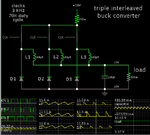bhl777
Full Member level 6
Hi All, I was looking at some datasheet of the interleaved buck converters.
Usually people design interleaved buck converter, and I am curious what is the problem if we do not have good interleave?
One drawback I can see is the output voltage ripple cancellation effect. Having a good phase shift can maximumly reduce the output voltage ripple. In addition to that, is there any other reasons we should use the interleave?
Thank you!
Usually people design interleaved buck converter, and I am curious what is the problem if we do not have good interleave?
One drawback I can see is the output voltage ripple cancellation effect. Having a good phase shift can maximumly reduce the output voltage ripple. In addition to that, is there any other reasons we should use the interleave?
Thank you!
